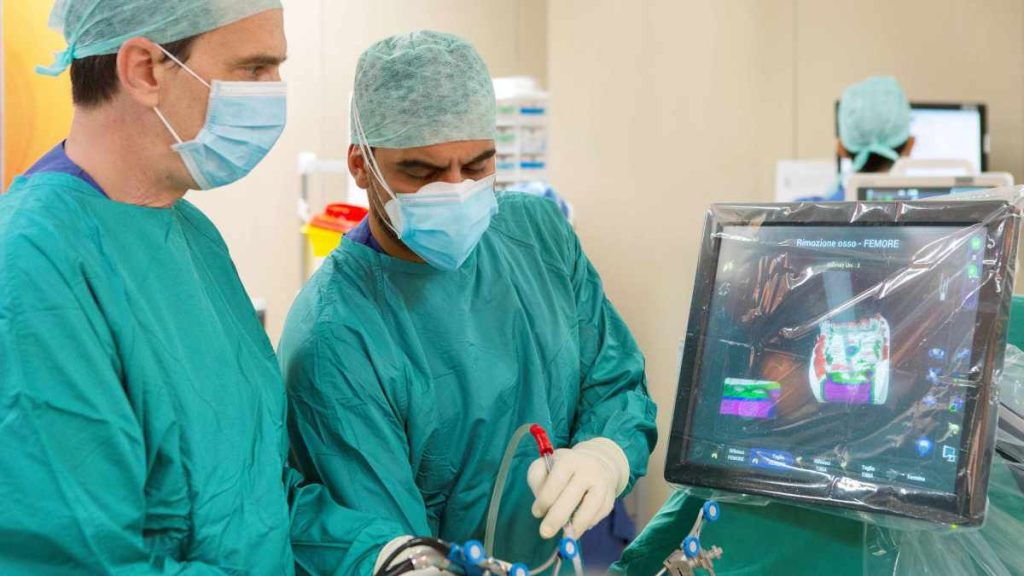Robotics For Prosthetics San Carlo Di Nancy Hospital:
Robotics For Prosthetics in the operating room are now a reality. But in this sector the “machines” are not designed to replace man. In fact, technological systems support the surgeon for minimally invasive, increasingly precise and conservative operations. The goal is less surgical trauma, greater implant precision and faster recovery.
As in the case of the Navio robotic system , present at the San Carlo di Nancy hospital in Rome since 2019. In the three-year period 2019-2022, almost 500 operations were performed with the Navio robot, of which around 200 in 2022, placing the Roman hospital among the top 3 hospitals in Europe for three-year case history of robotic knee implants and first place in Italy for number of robot-assisted UKA procedures(Unicompartmental Knee Arthroplasty – unicompartmental knee prosthesis).
With a daily average of 8 operations, the San Carlo di Nancy hospital is reconfirmed in the top 3 of the Lazio regional report by number of knee prostheses ( source: P.Re.Val.E. Lazio 2022 ).
“I am particularly proud of the goals achieved in these first 3 years of using the robotic technique associated with knee replacement surgery and this experience has improved our approach to this surgery forcing us to raise our technical level. Robotics For Prosthetics believe that the use of the robot is already today a consolidated reality which cannot be ignored in the future to ensure ever better results for our patients and our center has the ambitious goal of becoming a point of reference for all colleagues who wish to approach this type of technology;Prof. Mario Tartarone , Head of the Department of Orthopedics and Traumatology and Head of the Prosthetic Surgery Unit of the San Carlo Hospital in Nancy.
Navio Robot:
The Navio robot does not replace the surgeon but supports his expertise, allowing accurate planning of the intervention, customized on the anatomy and specific movement of the patient’s joint . Sensors that reconstruct a 3D image of the articular surfacesthey allow to define the exact positioning and the precise measurement of the prosthetic components but above all they allow to restore an accurate ligament balance of the knee. Then, in the operating room, during the operation, the computer-assisted “robotic handpiece” guides the surgeon’s performance. Patients who are candidates for knee replacement surgery are both elderly, due to joint degeneration, and young, often due to sports or road injuries.
Another novelty that sees the San Carlo di Nancy hospital alongside centers of excellence from all over the world is the monitoring program for the long-term follow-up of robotic prosthetic surgery. In fact, Robotics For Prosthetics the Roman hospital is part, together with other structures in Italy, the United Kingdom, Ireland, Germany, Spain, South Africa, the Netherlands and Belgium, of the Robotics Registry, a project that will be launched in the first quarter of 2023 and aims to lay the foundations for new standards of care in the field of robotics in the operating room.
This is a monitoring with the active participation of the patient, who will be able to provide data on his pre- and post-operative path through an app installed on his smartphone; on the other hand, Robotics For Prosthetics the medical team can also analyze the data received to monitor the therapeutic pathway both of the individual patient and, on a large scale, of all the patients involved in the project at the EMEA level (Europe, Middle East and Africa), also useful to the eventual production of scientific publications.
Project:
The aim of the project is to demonstrate the efficiency of robotic technology in total and unicompartmental prosthetic procedures for the improvement of the standard of care offered to patients and for the optimization of the therapeutic pathways proposed by the clinics through the analysis of data collected on the platform Robotics Registry, which can be consulted by the Healthcare and Administrative Personnel of the Hospital Structures involved in the project and by Smith+Nephew (manufacturer, among others, of the Navio).







